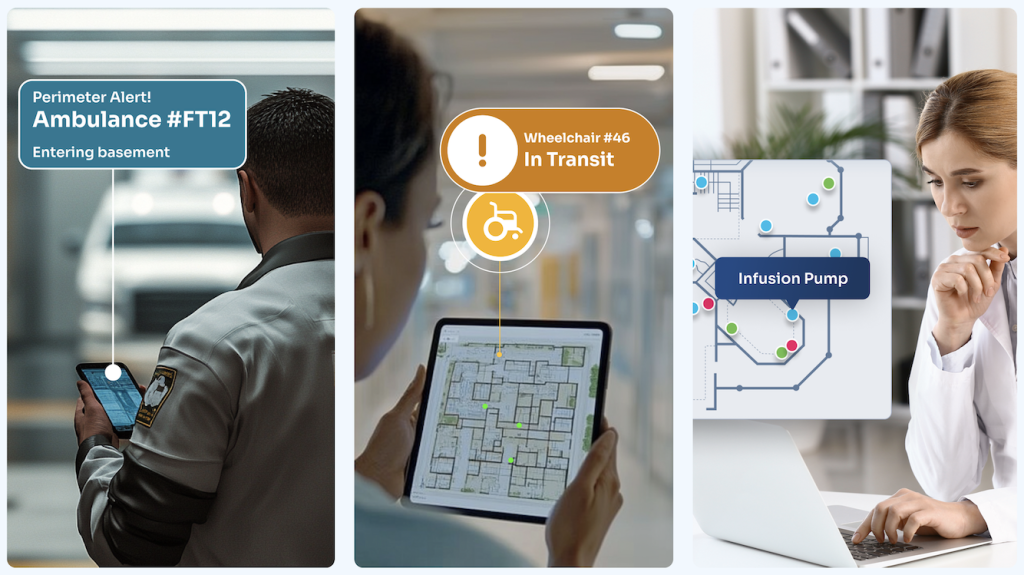
Traditional asset tracking methods often rely on manual checks or barcode scanning, which provide only intermittent data and require significant human intervention. The preferred alternative – IoT Asset Tracking – offers automated, constant monitoring and data collection, enabling more precise and efficient tracking of assets on a scale and in accuracy that traditional methods cannot match.
What is IoT Asset Tracking?
IoT-enabled asset tracking is a system that employs the Internet of Things (IoT) technology to monitor and manage the location, status, and condition of physical assets in real-time. This process involves using devices such as Wi-Fi, GPS tags, RFID, sensors, and smart labels to facilitate the tracking of assets, which can include high value equipment, IT devices, tools, vehicles, and more
How Does IoT Asset Tracking Work?
IoT asset tracking begins with attaching IoT sensors to the assets that need monitoring. These sensors collect data on various parameters such as location, temperature, motion, and more. The collected data is then transmitted via various communication methods like cellular networks, Bluetooth, or RFID, which are crucial for ensuring the data reaches the central system without significant delays.
The choice of data transfer method depends on the range, power availability, and the specific tracking requirements, playing a key role in enabling real-time monitoring and efficient remote tracking of assets across different environments and locations. This continuous stream of data allows businesses to make informed decisions quickly, enhancing operational efficiency and asset security.
Long vs. Short-Range IoT Asset Tracking Solutions
Long-range IoT asset tracking solutions, such as GPS, are designed to monitor assets over vast distances, making them ideal for tracking vehicles, shipping containers, or any asset that moves across large geographic areas. Short-range solutions, including Bluetooth Low Energy (BLE) and RFID, are suited for environments where assets do not travel long distances but require precise, real-time location data. These technologies are perfect for indoor tracking applications, such as managing inventory in warehouses, locating equipment in hospitals, or tracking items within a retail store, where specific location accuracy within a shorter range is crucial.
Benefits of IoT Asset Tracking Systems
Real-Time Asset Location
Real-time visibility into asset locations through IoT tracking, significantly reduces the time and resources spent on manual tracking efforts, thereby streamlining operational workflows and increasing productivity. Instant data access like this is particularly crucial in large or complex facilities. It helps minimize loss or misplaced assets, ensuring they are always accurately accounted for and readily available. This capability not only saves valuable time and reduces operational costs but also enhances overall asset management efficiency.
Improved Inventory Control
IoT asset tracking revolutionizes inventory management by offering continuous visibility into stock levels and asset movements, allowing for real-time tracking of inventory across different locations. This accurate and immediate access to data drastically reduces inventory discrepancies, helps avoid overstocking or stockouts, and streamlines restocking processes. As a result, organizations can significantly improve their supply chain efficiency.
Enhanced Security & Theft Prevention
IoT asset tracking serves as an effective deterrent against theft by continuously monitoring the location and movement of high-value assets, instantly alerting stakeholders when these assets leave predefined areas or exhibit unauthorized movement. This proactive approach not only helps in the rapid recovery of lost or stolen equipment but also significantly reduces the likelihood of theft occurring, as the presence of asset tracking technologies acts as a strong deterrent against unauthorized access and potential loss of equipment.
Maintenance Optimization
IoT asset tracking technologies empower organizations to monitor the condition of their assets in real-time, such as temperature, or wear, which facilitates the scheduling of maintenance activities based on actual usage patterns or environmental conditions rather than on fixed intervals. This shift towards proactive maintenance helps not only in extending the lifespan of assets but also in significantly reducing unplanned downtime, thereby maintaining consistent operational efficiency and avoiding the high costs associated with reactive repairs.
Regulatory Compliance & Data Logging
In IoT asset tracking, accurate and detailed records of asset location, usage, and status are constantly collected and easily accessible for regulatory review. This aids in maintaining compliance. In industries such as healthcare and food services, which are subject to strict regulatory requirements, this level of precision in tracking not only supports adherence to critical health and safety standards, but also provides verifiable audit trails that demonstrate compliance with industry-specific regulations. This can protect organizations from non-compliance penalties and enhance operational transparency.
Cost Savings & Operational Efficiency
IoT asset tracking offers significant cost-saving benefits by reducing asset losses through precise location tracking, optimizing asset utilization with data-driven insights, and minimizing the need for manual inventory management, therefore cutting down on labor costs. IoT technology also helps reduce human error and streamlines asset management. This ensures efficient and effective asset use. It also adds up to cost savings across various facets of an organization’s operations, in addition to improving operational efficiency.
IoT Asset Tracking Applications Across Industries
IoT Asset Tracking in Construction
In the construction industry, it monitors the movement and condition of equipment and materials across various job sites. This enables managers to have real-time visibility on the location and status of their assets. This capability is especially crucial for tracking high-value assets, ensuring they are not only secure against theft or misuse but also well-maintained and in optimal working condition, thereby preventing project delays and promoting efficient use of resources.
IoT Asset Tracking in Healthcare
In healthcare facilities, it plays a vital role in managing critical equipment such as wheelchairs, ventilators, and other essential medical assets by providing accurate information on their location and availability. This technology helps reduce delays in patient care by ensuring that the necessary equipment is readily available when needed, thereby improving the efficiency of healthcare delivery and patient outcomes.
IoT Asset Tracking in Manufacturing
Manufacturers leverage IoT asset tracking to monitor equipment and materials continuously throughout the production process, gaining invaluable insights into the location and status of these assets in real-time. This tracking capability is crucial for preventing production delays, as it ensures assets are precisely where they need to be and readily available when needed, thereby maintaining a smooth and efficient production flow.
Key Considerations for Implementing IoT Asset Tracking
Important considerations when implementing this solution include the type of assets to be tracked, the required accuracy of tracking, and the available connectivity options, such as Wi-Fi or Bluetooth. It is crucial to choose a system that provides the precise level of tracking needed for the specific assets, whether they are high-value equipment or bulk inventory items. Additionally, opting for a scalable solution is essential, as it ensures the ability to adapt to evolving business needs and expanding asset management requirements.
Cisco Spaces IoT Asset Tracking
Cisco Spaces’ cloud-based Asset Tracking solution enables enterprises to automatically manage, monitor, maintain and optimize their indoor assets. It is a cutting-edge solution that integrates seamlessly with existing Cisco network infrastructure, offering an advanced asset tracking system.
Spaces gathers asset location telemetry from Wi-Fi based devices as well as IoT-based asset tags without the need for additional IoT gateways. Such a design makes it an exceptionally cost-effective solution to provide precise, real-time visibility of assets across various environments, thereby enhancing operational efficiency without significant extra investment in new hardware.
This innovative approach also allows businesses to streamline their asset management processes, maximizing the value of their current network investments. By integrating smoothly with Cisco network hardware, Cisco Spaces provides a more efficient solution for comprehensive asset visibility and management.
Explore Cisco Spaces as a reliable and cost-effective solution for IoT asset tracking.


